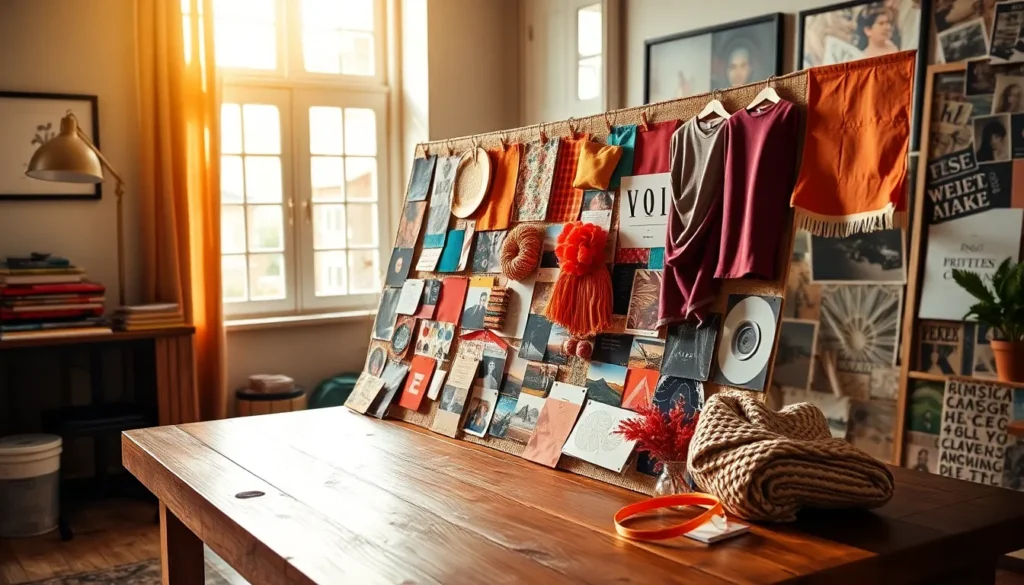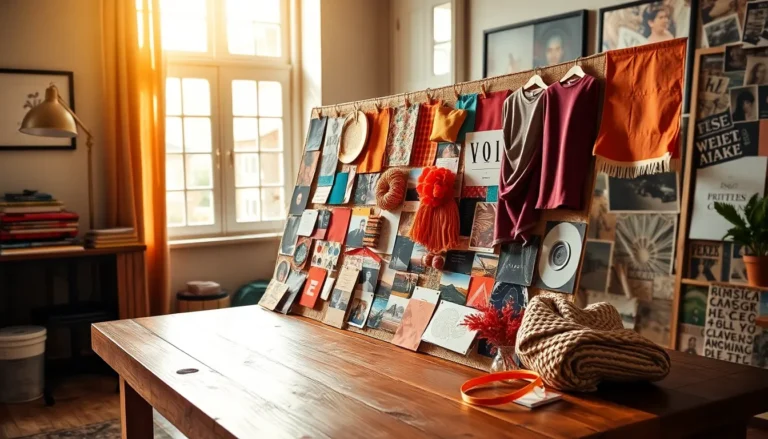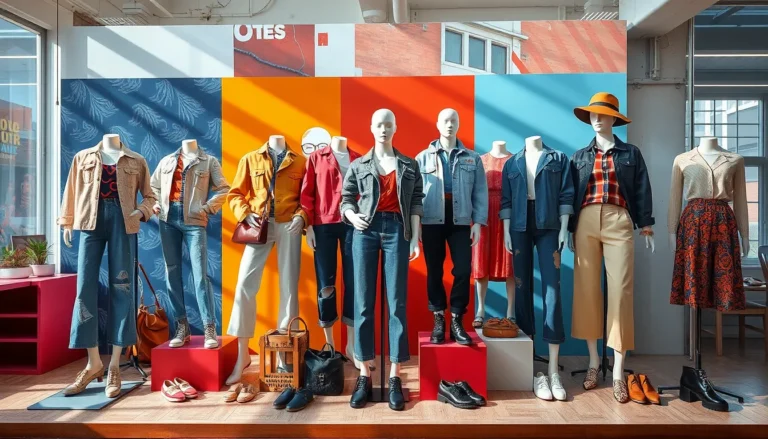Table of Contents
ToggleMood boards are powerful tools that ignite creativity and streamline the design process. They serve as visual collages, bringing together colors, textures, images, and ideas to convey a specific theme or emotion. Whether for a personal project, a marketing campaign, or interior design, mood boards help individuals and teams align their visions and inspire innovative solutions.
In today’s fast-paced world, capturing the essence of a concept can be challenging. Mood boards simplify this by providing a tangible reference point, allowing creators to visualize their ideas cohesively. With the rise of digital platforms, creating mood boards has never been easier, making them an essential resource for anyone looking to elevate their creative endeavors.
What Are Mood Boards?
Mood boards serve as creative tools that visually convey a specific theme or emotion. They combine elements like colors, textures, images, and concepts, providing a reference point for design projects.
Definition and Purpose
Mood boards are collages that aggregate various visual elements, including photographs, fabric swatches, color palettes, and typography. Their primary purpose is to encapsulate an idea or evoke a particular feeling, aiding designers and teams in aligning their creative direction. Mood boards enhance communication, clarify vision, and foster inspiration through a concise visual representation of themes.
Types of Mood Boards
- Physical Mood Boards: These boards involve tangible elements like printed images, fabric samples, and other materials, allowing creators to manipulate textures and colors directly.
- Digital Mood Boards: Digital platforms like Canva and Pinterest enable users to create and share mood boards electronically, offering flexibility and ease of access to a wider range of resources.
- Conceptual Mood Boards: These focus on abstract ideas, utilizing graphics and artistic visuals to represent broader themes rather than specific color schemes or designs.
- Directional Mood Boards: These guide the overall creative direction of a project, emphasizing specific design choices, such as styles or moods, to influence the final output.
- Brand Mood Boards: These showcase branding elements, including logos, color schemes, and typography, reflecting a brand’s identity and aesthetic to ensure consistency across marketing materials.
Benefits of Using Mood Boards

Mood boards offer multiple benefits that enhance creativity and communication across various projects. They serve as visual tools that streamline the design process.
Inspiration and Creativity
Inspiration thrives on visual engagement. Mood boards provide a unique platform for individuals to compile images, colors, and elements that resonate with their creative vision. They act as repositories for ideas, allowing designers and teams to explore diverse aesthetics. By visually stimulating creativity, mood boards encourage experimentation and foster innovative solutions in design projects.
Visualization of Ideas
Visualization makes concepts tangible. Mood boards transform abstract ideas into concrete visuals, enabling clearer communication of themes and concepts. They facilitate discussions among team members, simplifying idea-sharing and ensuring alignment on project visions. This clarity minimizes misunderstandings and raises efficiency in design processes, ultimately leading to more successful outcomes.
How to Create a Mood Board
Creating a mood board involves a straightforward process that combines inspiration, tools, and techniques. The following sections detail the essential tools and materials needed, as well as the steps to craft an effective mood board.
Tools and Materials Needed
- Board or Canvas: A sturdy base, such as a corkboard, foam board, or a digital canvas.
- Adhesive: Glue, tape, or pins for physical boards; digital tools come with built-in features.
- Images: Photographs, illustrations, or any visual elements that embody the theme.
- Color Swatches: Paint samples, fabric swatches, or printed colors that align with the vision.
- Typography Samples: Character styles that reflect the intended message or aesthetic.
- Digital Tools: Platforms like Canva, Pinterest, or Adobe Spark for creating digital mood boards.
Steps to Crafting Your Mood Board
- Define the Theme: Identify the primary message or emotion to convey. Consider elements like color, texture, and mood.
- Gather Inspiration: Collect visual elements from various sources, including magazines, websites, or nature, focusing on elements that evoke the desired feel.
- Select a Format: Decide on a physical or digital format based on convenience and preference. Each format has unique advantages for presentation.
- Arrange Elements: Layout the collected visuals on the board. Experiment with spacing, alignment, and overall composition to create a visually appealing arrangement.
- Refine and Edit: Remove any elements that don’t fit with the overall theme. Focus on clarity and coherence, ensuring each piece enhances the mood board’s message.
- Finalize the Board: Secure elements in place using adhesive for physical boards or save the arrangement for digital boards. Make sure the final presentation fully represents the intended theme or emotion.
Best Practices for Effective Mood Boards
Creating an effective mood board requires thoughtful curation and attention to detail. Following best practices enhances the overall quality and impact of the design.
Selecting the Right Images
Choosing the right images forms the backbone of a successful mood board. Images should align with the overall theme and evoke the desired emotions.
- Relevance: Ensure each image directly connects to the concept being presented. Irrelevant visuals dilute the board’s impact.
- Quality: Opt for high-resolution images to maintain clarity and professional appearance. Blurry or pixelated images detract from the board’s effectiveness.
- Variety: Incorporate diverse visuals, such as photography, illustrations, and graphics. This variety enriches the overall aesthetic and reflects a broader interpretation of the theme.
Color and Theme Consistency
Maintaining color and theme consistency is crucial for cohesion. A unified look enhances the messaging of the mood board.
- Color Palette: Select a limited color palette that complements the theme. Use color theory principles to choose harmonious shades. Consistent color choices create a cohesive visual narrative.
- Visual Elements: All chosen images, textures, and typography should reflect the same theme. This alignment ensures clarity and reinforces the intended message.
- Refinement: Regularly revisit the board to assess consistency. Remove elements that don’t fit the overall vision to keep the focus sharp and clear.
Mood boards are invaluable tools that streamline the creative process and inspire innovation. By visually compiling elements that resonate with a specific theme or emotion, they help individuals and teams communicate their ideas more effectively. Whether for personal projects or professional campaigns, mood boards enhance clarity and foster collaboration.
With the rise of digital platforms, creating mood boards has never been easier. This accessibility empowers anyone to harness their creativity and bring their visions to life. By following best practices and focusing on thoughtful curation, mood boards can serve as powerful references that guide design decisions and ensure cohesive outcomes. Embracing the art of mood boarding can transform abstract concepts into compelling visuals that truly reflect one’s creative aspirations.




